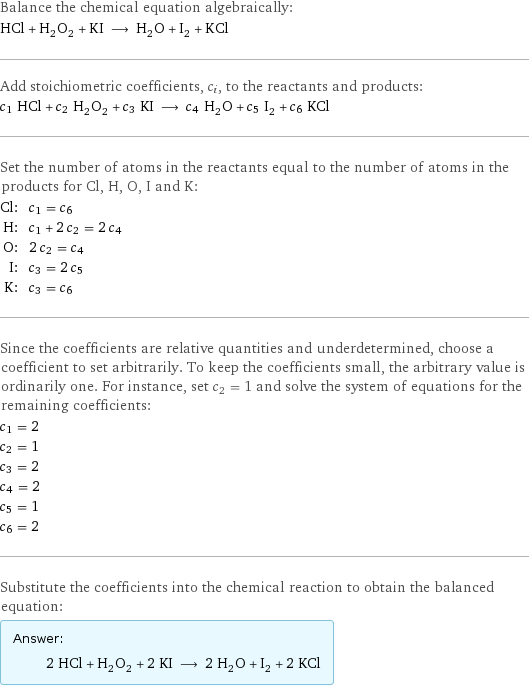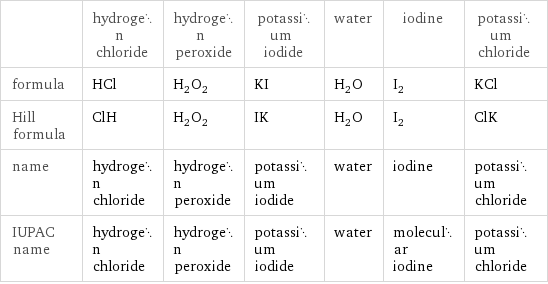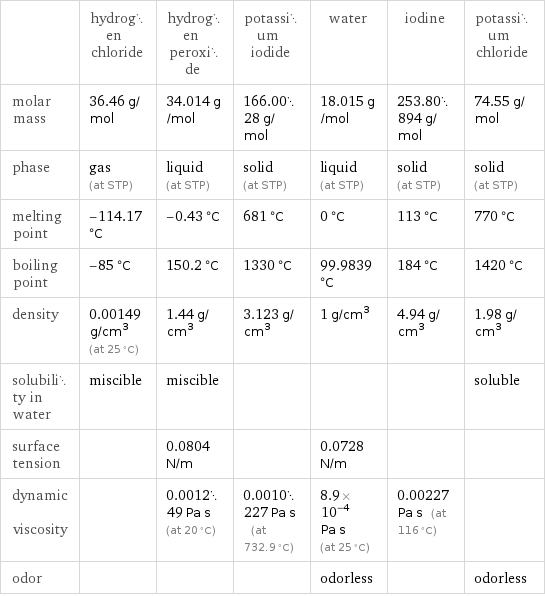Input interpretation

HCl hydrogen chloride + H_2O_2 hydrogen peroxide + KI potassium iodide ⟶ H_2O water + I_2 iodine + KCl potassium chloride
Balanced equation

Balance the chemical equation algebraically: HCl + H_2O_2 + KI ⟶ H_2O + I_2 + KCl Add stoichiometric coefficients, c_i, to the reactants and products: c_1 HCl + c_2 H_2O_2 + c_3 KI ⟶ c_4 H_2O + c_5 I_2 + c_6 KCl Set the number of atoms in the reactants equal to the number of atoms in the products for Cl, H, O, I and K: Cl: | c_1 = c_6 H: | c_1 + 2 c_2 = 2 c_4 O: | 2 c_2 = c_4 I: | c_3 = 2 c_5 K: | c_3 = c_6 Since the coefficients are relative quantities and underdetermined, choose a coefficient to set arbitrarily. To keep the coefficients small, the arbitrary value is ordinarily one. For instance, set c_2 = 1 and solve the system of equations for the remaining coefficients: c_1 = 2 c_2 = 1 c_3 = 2 c_4 = 2 c_5 = 1 c_6 = 2 Substitute the coefficients into the chemical reaction to obtain the balanced equation: Answer: | | 2 HCl + H_2O_2 + 2 KI ⟶ 2 H_2O + I_2 + 2 KCl
Structures

+ + ⟶ + +
Names

hydrogen chloride + hydrogen peroxide + potassium iodide ⟶ water + iodine + potassium chloride
Reaction thermodynamics
Gibbs free energy

| hydrogen chloride | hydrogen peroxide | potassium iodide | water | iodine | potassium chloride molecular free energy | -95.3 kJ/mol | -120.4 kJ/mol | -324.9 kJ/mol | -237.1 kJ/mol | 0 kJ/mol | -408.5 kJ/mol total free energy | -190.6 kJ/mol | -120.4 kJ/mol | -649.8 kJ/mol | -474.2 kJ/mol | 0 kJ/mol | -817 kJ/mol | G_initial = -960.8 kJ/mol | | | G_final = -1291 kJ/mol | | ΔG_rxn^0 | -1291 kJ/mol - -960.8 kJ/mol = -330.4 kJ/mol (exergonic) | | | | |
Equilibrium constant
![Construct the equilibrium constant, K, expression for: HCl + H_2O_2 + KI ⟶ H_2O + I_2 + KCl Plan: • Balance the chemical equation. • Determine the stoichiometric numbers. • Assemble the activity expression for each chemical species. • Use the activity expressions to build the equilibrium constant expression. Write the balanced chemical equation: 2 HCl + H_2O_2 + 2 KI ⟶ 2 H_2O + I_2 + 2 KCl Assign stoichiometric numbers, ν_i, using the stoichiometric coefficients, c_i, from the balanced chemical equation in the following manner: ν_i = -c_i for reactants and ν_i = c_i for products: chemical species | c_i | ν_i HCl | 2 | -2 H_2O_2 | 1 | -1 KI | 2 | -2 H_2O | 2 | 2 I_2 | 1 | 1 KCl | 2 | 2 Assemble the activity expressions accounting for the state of matter and ν_i: chemical species | c_i | ν_i | activity expression HCl | 2 | -2 | ([HCl])^(-2) H_2O_2 | 1 | -1 | ([H2O2])^(-1) KI | 2 | -2 | ([KI])^(-2) H_2O | 2 | 2 | ([H2O])^2 I_2 | 1 | 1 | [I2] KCl | 2 | 2 | ([KCl])^2 The equilibrium constant symbol in the concentration basis is: K_c Mulitply the activity expressions to arrive at the K_c expression: Answer: | | K_c = ([HCl])^(-2) ([H2O2])^(-1) ([KI])^(-2) ([H2O])^2 [I2] ([KCl])^2 = (([H2O])^2 [I2] ([KCl])^2)/(([HCl])^2 [H2O2] ([KI])^2)](../image_source/764bf704cddecc8c6e40420309dd31a8.png)
Construct the equilibrium constant, K, expression for: HCl + H_2O_2 + KI ⟶ H_2O + I_2 + KCl Plan: • Balance the chemical equation. • Determine the stoichiometric numbers. • Assemble the activity expression for each chemical species. • Use the activity expressions to build the equilibrium constant expression. Write the balanced chemical equation: 2 HCl + H_2O_2 + 2 KI ⟶ 2 H_2O + I_2 + 2 KCl Assign stoichiometric numbers, ν_i, using the stoichiometric coefficients, c_i, from the balanced chemical equation in the following manner: ν_i = -c_i for reactants and ν_i = c_i for products: chemical species | c_i | ν_i HCl | 2 | -2 H_2O_2 | 1 | -1 KI | 2 | -2 H_2O | 2 | 2 I_2 | 1 | 1 KCl | 2 | 2 Assemble the activity expressions accounting for the state of matter and ν_i: chemical species | c_i | ν_i | activity expression HCl | 2 | -2 | ([HCl])^(-2) H_2O_2 | 1 | -1 | ([H2O2])^(-1) KI | 2 | -2 | ([KI])^(-2) H_2O | 2 | 2 | ([H2O])^2 I_2 | 1 | 1 | [I2] KCl | 2 | 2 | ([KCl])^2 The equilibrium constant symbol in the concentration basis is: K_c Mulitply the activity expressions to arrive at the K_c expression: Answer: | | K_c = ([HCl])^(-2) ([H2O2])^(-1) ([KI])^(-2) ([H2O])^2 [I2] ([KCl])^2 = (([H2O])^2 [I2] ([KCl])^2)/(([HCl])^2 [H2O2] ([KI])^2)
Rate of reaction
![Construct the rate of reaction expression for: HCl + H_2O_2 + KI ⟶ H_2O + I_2 + KCl Plan: • Balance the chemical equation. • Determine the stoichiometric numbers. • Assemble the rate term for each chemical species. • Write the rate of reaction expression. Write the balanced chemical equation: 2 HCl + H_2O_2 + 2 KI ⟶ 2 H_2O + I_2 + 2 KCl Assign stoichiometric numbers, ν_i, using the stoichiometric coefficients, c_i, from the balanced chemical equation in the following manner: ν_i = -c_i for reactants and ν_i = c_i for products: chemical species | c_i | ν_i HCl | 2 | -2 H_2O_2 | 1 | -1 KI | 2 | -2 H_2O | 2 | 2 I_2 | 1 | 1 KCl | 2 | 2 The rate term for each chemical species, B_i, is 1/ν_i(Δ[B_i])/(Δt) where [B_i] is the amount concentration and t is time: chemical species | c_i | ν_i | rate term HCl | 2 | -2 | -1/2 (Δ[HCl])/(Δt) H_2O_2 | 1 | -1 | -(Δ[H2O2])/(Δt) KI | 2 | -2 | -1/2 (Δ[KI])/(Δt) H_2O | 2 | 2 | 1/2 (Δ[H2O])/(Δt) I_2 | 1 | 1 | (Δ[I2])/(Δt) KCl | 2 | 2 | 1/2 (Δ[KCl])/(Δt) (for infinitesimal rate of change, replace Δ with d) Set the rate terms equal to each other to arrive at the rate expression: Answer: | | rate = -1/2 (Δ[HCl])/(Δt) = -(Δ[H2O2])/(Δt) = -1/2 (Δ[KI])/(Δt) = 1/2 (Δ[H2O])/(Δt) = (Δ[I2])/(Δt) = 1/2 (Δ[KCl])/(Δt) (assuming constant volume and no accumulation of intermediates or side products)](../image_source/c54c901de3233d175db78999beee25af.png)
Construct the rate of reaction expression for: HCl + H_2O_2 + KI ⟶ H_2O + I_2 + KCl Plan: • Balance the chemical equation. • Determine the stoichiometric numbers. • Assemble the rate term for each chemical species. • Write the rate of reaction expression. Write the balanced chemical equation: 2 HCl + H_2O_2 + 2 KI ⟶ 2 H_2O + I_2 + 2 KCl Assign stoichiometric numbers, ν_i, using the stoichiometric coefficients, c_i, from the balanced chemical equation in the following manner: ν_i = -c_i for reactants and ν_i = c_i for products: chemical species | c_i | ν_i HCl | 2 | -2 H_2O_2 | 1 | -1 KI | 2 | -2 H_2O | 2 | 2 I_2 | 1 | 1 KCl | 2 | 2 The rate term for each chemical species, B_i, is 1/ν_i(Δ[B_i])/(Δt) where [B_i] is the amount concentration and t is time: chemical species | c_i | ν_i | rate term HCl | 2 | -2 | -1/2 (Δ[HCl])/(Δt) H_2O_2 | 1 | -1 | -(Δ[H2O2])/(Δt) KI | 2 | -2 | -1/2 (Δ[KI])/(Δt) H_2O | 2 | 2 | 1/2 (Δ[H2O])/(Δt) I_2 | 1 | 1 | (Δ[I2])/(Δt) KCl | 2 | 2 | 1/2 (Δ[KCl])/(Δt) (for infinitesimal rate of change, replace Δ with d) Set the rate terms equal to each other to arrive at the rate expression: Answer: | | rate = -1/2 (Δ[HCl])/(Δt) = -(Δ[H2O2])/(Δt) = -1/2 (Δ[KI])/(Δt) = 1/2 (Δ[H2O])/(Δt) = (Δ[I2])/(Δt) = 1/2 (Δ[KCl])/(Δt) (assuming constant volume and no accumulation of intermediates or side products)
Chemical names and formulas

| hydrogen chloride | hydrogen peroxide | potassium iodide | water | iodine | potassium chloride formula | HCl | H_2O_2 | KI | H_2O | I_2 | KCl Hill formula | ClH | H_2O_2 | IK | H_2O | I_2 | ClK name | hydrogen chloride | hydrogen peroxide | potassium iodide | water | iodine | potassium chloride IUPAC name | hydrogen chloride | hydrogen peroxide | potassium iodide | water | molecular iodine | potassium chloride
Substance properties

| hydrogen chloride | hydrogen peroxide | potassium iodide | water | iodine | potassium chloride molar mass | 36.46 g/mol | 34.014 g/mol | 166.0028 g/mol | 18.015 g/mol | 253.80894 g/mol | 74.55 g/mol phase | gas (at STP) | liquid (at STP) | solid (at STP) | liquid (at STP) | solid (at STP) | solid (at STP) melting point | -114.17 °C | -0.43 °C | 681 °C | 0 °C | 113 °C | 770 °C boiling point | -85 °C | 150.2 °C | 1330 °C | 99.9839 °C | 184 °C | 1420 °C density | 0.00149 g/cm^3 (at 25 °C) | 1.44 g/cm^3 | 3.123 g/cm^3 | 1 g/cm^3 | 4.94 g/cm^3 | 1.98 g/cm^3 solubility in water | miscible | miscible | | | | soluble surface tension | | 0.0804 N/m | | 0.0728 N/m | | dynamic viscosity | | 0.001249 Pa s (at 20 °C) | 0.0010227 Pa s (at 732.9 °C) | 8.9×10^-4 Pa s (at 25 °C) | 0.00227 Pa s (at 116 °C) | odor | | | | odorless | | odorless
Units
